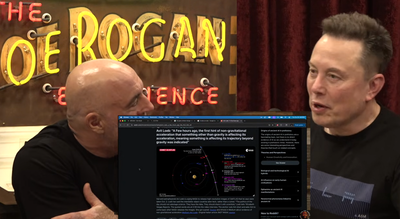The interstellar visitor 3I/ATLAS has only been in our skies since July, but it’s already triggered one of the strangest scientific and cultural debates of the year. Astronomers are still arguing over what it actually is, a natural comet, a relic from a dead star system, or, if you ask Harvard astrophysicist Avi Loeb, something far more engineered. And now Elon Musk has stepped into the conversation with warnings of “alien” possibilities, continent-level destruction, and one unexpected promise: if he ever finds real evidence of extraterrestrials, he’ll reveal it live on The Joe Rogan Experience.
A mysterious visitor and an even stranger debate
3I/ATLAS first appeared on astronomers’ radars in July, immediately raising questions because of its unusual behaviour. Loeb told LADbible he believes there is a “30 to 40 percent” chance the object isn’t naturally formed, accusing NASA of “pretending to be the adults in the room” by dismissing any otherworldly explanation. He has even floated the possibility of an “alien mothership”, pointing to images he claims show a “hot engine or source of artificial light.” The object has temporarily vanished behind the Sun and will re-emerge in early December, which NASA says will allow for “renewed observations.” Scientists believe 3I/ATLAS could be one of the oldest objects of its kind, originating from the “frontier” region of the Milky Way up to seven billion years ago.
What the new radio signal actually means
Excitement spiked when experts detected a radio signal from the object during its closest approach to the Sun on 29 October. The discovery, made by the MeerKAT array, 64 interlinked radio dishes in South Africa — initially shocked observers and fuelled speculation online. But researchers quickly concluded the signal was natural. The radio emission was traced to hydroxyl radicals (OH molecules) in the comet’s coma. These form when solar radiation splits water vapour released through outgassing, the same process that produces a classic comet tail. In simple terms: the signal wasn’t a message; it was chemistry. The detection confirms 3I/ATLAS contains volatile compounds like water, behaving much like comets within our own solar system. Professor Brian Cox has publicly rejected the alien theories altogether, calling them “drivel” and describing 3I/ATLAS as a “pristine lump of rock and ices” likely billions of years old.
Musk weighs in: “It could be alien… or worse”
When Musk addressed 3I/ATLAS on The Joe Rogan Experience, he didn’t rule out the possibility of an extraterrestrial origin. He acknowledged that “the object could be alien,” while stressing that he would publicly disclose anything he knew. “If I was aware of any evidence of aliens… you have my word, I will come on your show and reveal it on the show,” he told Rogan, who immediately responded, “I’ll hold you to that.”
Musk also discussed the object’s sheer scale and composition, responding to Rogan’s observation that something “the size of Manhattan and all nickel” would be catastrophic. Musk agreed that an impact of that magnitude “would obliterate a continent type of thing… maybe worse,” prompting Rogan to suggest it could “kill most of human life, if not all of us.” Musk didn’t push the idea further but noted that Earth’s history includes multiple extinction-level events, pointing to the Permian and Jurassic eras as evidence that planet-shaping impacts are not hypothetical.
Natural or not? The split between science and speculation
While Loeb keeps 3I/ATLAS at a “four” on his personal scale of extraterrestrial likelihood, where 10 represents confirmed alien technology, most astronomers remain firmly anchored in natural explanations. Researchers point out that everything observed so far aligns with normal comet behaviour: the non-gravitational accelerations can be explained by uneven outgassing, the temporary colour shift near perihelion was expected as it passed closest to the Sun, and the radio signal detected by MeerKAT matched the hydroxyl emissions produced when ultraviolet radiation breaks apart water molecules in a comet’s coma. Even its trajectory fits the profile of an interstellar visitor, a point Professor Brian Cox emphasised when he said it will “whizz around the sun and disappear off into the galaxy again.”At roughly the size of New York, 3I/ATLAS is unusually large for an object of its kind and only the third interstellar body ever recorded entering our solar system, which partly explains why public speculation has run so wild. But despite the internet’s fixation on alien theories, the scientific consensus remains unchanged: there is no evidence that the object is artificial.At least, not yet, and it is that lingering uncertainty, amplified by its brief disappearance behind the Sun and its return in December, that keeps the mystery very much alive. Go to Source



